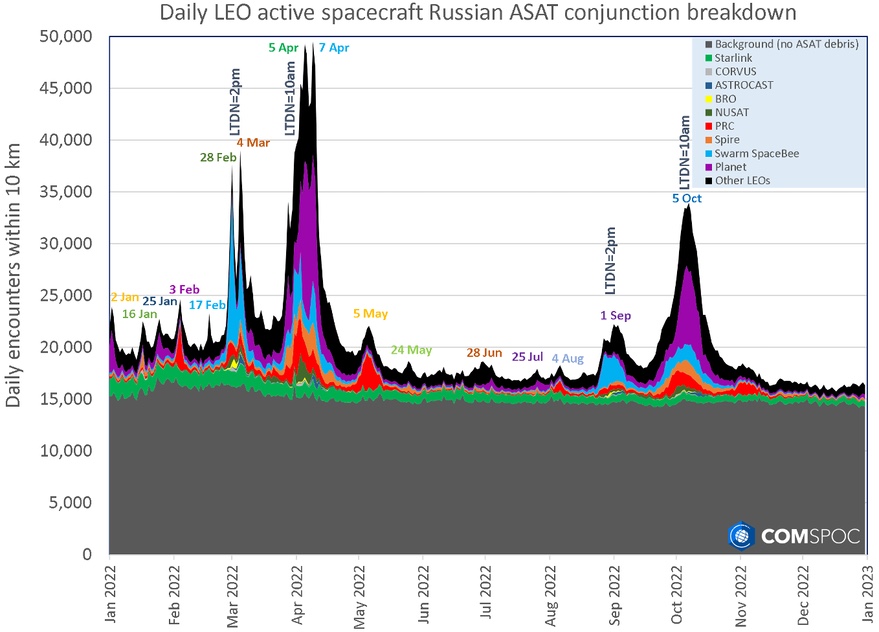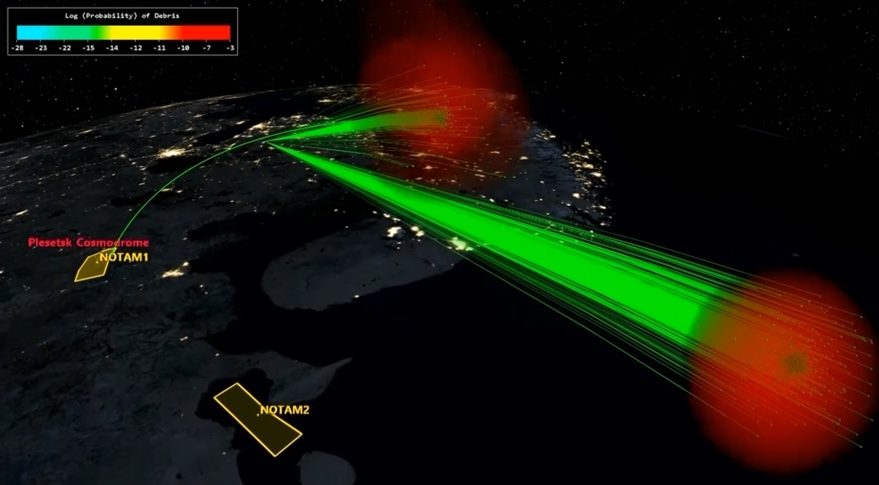WASHINGTON — Debris from a Russian antisatellite weapon demonstration in November are creating surges of close approaches, in some cases tens of thousands in a week, with active satellites in low Earth orbit.
Such events, dubbed “conjunction squalls” by space situational awareness company COMSPOC, were first noticed in January and stem from the unique circumstances of the Nov. 15 Russian ASAT test that destroyed the Cosmos 1408 satellite and created thousands of pieces of debris.
The squalls can result in thousands of close approaches, or conjunctions, over just a few days. “In the first week of April, in that week alone, there will be 40,000 conjunctions that we predict purely from that one event,” said Travis Langster, vice president and general manager of COMSPOC, during a panel at the 24th annual FAA Commercial Space Transportation Conference Feb. 17.
Those surges come from the interaction of the Cosmos 1408 debris with constellations of remote sensing satellites. Cosmos 1408 was in an orbit at an inclination of 82.3 degrees, while many remote sensing satellites are in sun-synchronous orbits with inclinations of about 97 degrees. As the orbits precess, the debris overlaps the orbits of remote sensing satellites — but going in the opposite direction.
“When they sync up, you have the perfect storm: they’re in the same orbit plane but counter rotating, crossing each other twice an orbit, again and again,” said Dan Oltrogge, director of integrated operations and research at COMSPOC, in an interview. Those squalls last for several days until the orbits precess out of sync.
COMSPOC first noticed a surge on conjunctions at the beginning of the year, linked to a group or “Flock” of Dove imaging cubesats operated by Planet. That first surge peaked at about 4,000 daily conjunctions, defined as approaches within 10 kilometers, on Jan. 2. A second conjunction squall, peaking at about 2,000 conjunctions a day Jan. 25, linked to another set of Planet satellites.
COMSPOC is predicting an even stronger conjunction squall in early April as the debris encounters several Flocks of Planet cubesats, including a peak of more than 14,000 conjunctions on a single day, April 5. Another squall is predicted with those same cubesats about six months later, but with a peak only about half as strong as debris spreads out and reenters.
Planet feels some of the strongest effects of the Russian ASAT debris because of the size of its constellation, but it is not alone. “This is no different for any Earth observing system that uses sun-synchronous orbits at this altitude,” Oltrogge said. “We expect that a lot will be affected.”

COMSPOC projects that, in the conjunction squall in early April, conjunctions involving all active satellites in low Earth orbit will peak at nearly 50,000 per day. That includes a background level of about 15,000 per day not associated with the ASAT test, along with those involving Planet’s satellites and with other companies and organizations, such as Satellogic, Spire and Swarm.
However, because many of those satellites are cubesats, the risk of collisions does not rise as dramatically. While the background average daily collision rate has a background level of about 0.0005, during the surge in early April it reaches a peak of only a little more than 0.0008.
Spacecraft outside of sun-synchronous orbits will also be affected, such as SpaceX’s Starlink constellation. COMSPOC predicts that, given SpaceX’s threshold of performing automated collision avoidance maneuvers when there is a 1-in-100,000 chance of a collision, the Starlink constellation will perform as many as 80 such maneuvers a day just from Russian ASAT debris, with a peak in early March.
Oltrogge warned that the conjunction squalls may overwhelm space situational awareness (SSA) systems and make it difficult for operators to identify other potential collisions. “The SSA systems, legacy and commercial, are all going to get hammered by this,” he said. “If you want to find a needle in a haystack, get rid of the hay. This is adding a lot of hay.”
